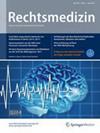松弛造成的创伤腰椎突出?
IF 0.5
4区 医学
Q4 MEDICINE, LEGAL
引用次数: 0
摘要
摘要背景一般来说,椎间盘的改变是退行性的,并在较长的时间跨度内发展。意外事件与孤立的外伤性椎间盘破裂是罕见的事件;然而,涉及低速事故的乘员经常声称圆盘变化与事故之间存在因果关系。在法医案件中,生物力学载荷是否足以引起外伤性椎间盘破裂必须进行评估。目的:根据患者资料,我们探讨了以下问题:外伤性颈椎间盘破裂是否发生在低速事故中?-神经放射成像是否总是伴有损伤?-主要的损伤机制是什么?方法在本研究中,我们分析了2010年至2021年间接受手术治疗的无其他严重损伤的外伤性椎间盘破裂病例。目的是确定低速情况下外伤性椎间盘破裂的病例。本组16例主要诊断为外伤性颈椎间盘破裂。结果跌落致外伤性椎间盘破裂14例,交通事故致椎间盘损伤2例。急性创伤的放射学征象以及感觉运动缺陷或疼痛在每个病例中都存在。其中6名患者没有伴随骨折。在大多数情况下,假设有一种超伸展机制,尽管在每种情况下都不可能精确地重建负载。结论:本研究表明,在低速情况下,创伤性椎间盘破裂的可能性很小。没有伴随损伤或急性创伤迹象(如出血、骨或韧带病变)的医学成像支持椎间盘改变的非意外原因。尽管如此,专家意见需要考虑到具体患者和具体情况,逐个进行评估。本文章由计算机程序翻译,如有差异,请以英文原文为准。
Traumatischer zervikaler Bandscheibenvorfall nach Niedriggeschwindigkeitsunfall?
Abstract Background Generally, disc changes are of degenerative origin and develop over a longer time span. Accidental incidents with isolated traumatic disc ruptures are rare events; however, occupants involved in low velocity accidents often claim a causal relationship between disc changes and accidents. In forensic casework the adequacy of the biomechanical load to cause traumatic disc rupture has to be assessed. Objective Based on patient data we addressed the following issues: – Do traumatic cervical disc rupture occur in low velocity accidents? – Are there always accompanying injuries in neuroradiological imaging? – What are the main injury mechanisms? Methods In this study we analyzed cases of traumatic disc ruptures without other severe injuries in patients who underwent surgical treatment between 2010 and 2021. The purpose was to identify cases with traumatic disc ruptures following low velocity scenarios. The sample contained 16 cases with the main diagnosis of traumatic cervical disc rupture. Results Falls caused traumatic disc rupture in 14 of the cases, while traffic accidents caused disc injury in 2 cases only. Radiological signs of acute trauma as well as sensorimotor deficits or pain were present in every case. Of the patients six did not sustain accompanying fractures. In the majority of cases a hyperextension mechanism was assumed, even though an exact reconstruction of the load was not possible in every case. Conclusion This study renders traumatic genesis of a disc rupture highly unlikely in patients involved in low velocity scenarios. Medical imaging without accompanying injuries or signs of acute trauma, e.g., in terms of bleeding, bony or ligamentous lesions, supports a non-accidental cause of disc changes. Nevertheless, expert opinions require case by case evaluation taking account of patient-specific and case-specific conditions.
求助全文
通过发布文献求助,成功后即可免费获取论文全文。
去求助
来源期刊

Rechtsmedizin
MEDICINE, LEGAL-
CiteScore
1.30
自引率
40.00%
发文量
45
审稿时长
6-12 weeks
期刊介绍:
Rechtsmedizin is an internationally recognized journal dealing with all aspects of forensic medicine. It provides information on current developments in forensic pathology, traumatology, traffic medicine, toxicology, serology, insurance medicine, psychopathology and legal medical issues.
Freely submitted original papers allow the presentation of important clinical studies and serve scientific exchange.
Case reports feature interesting and unique cases thus providing a platform for scientific information and critical discussion.
Comprehensive reviews on a specific topical issue focus on providing evidenced based information on all aspects of the field.
Review articles under the rubric ''Continuing Medical Education'' present verified results of scientific research and their integration into daily practice.
 求助内容:
求助内容: 应助结果提醒方式:
应助结果提醒方式:


